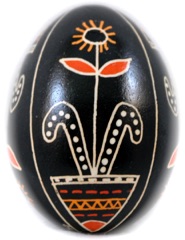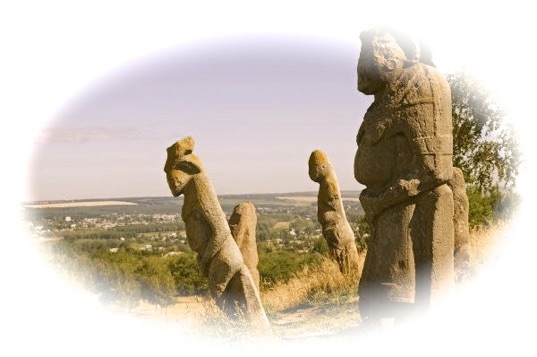Berehynia

The goddess motif is an ancient one, and most often found in pysanky from Polissia, Bukovyna and Podillia. The berehynia was believed to be the source of life and death. On the one hand, she is a life giving mother, the creator of heaven and all living things, and the mistress of heavenly water (rain), upon which the world relies for fertility and fruitfulness. On the other hand, she was the merciless controller of destinies.
Berehynia depictions fall into three general categories:
“BOHYNIA” The goddess is sometimes depicted with arms upraised, and the arms vary in number but are always in pairs: 2, 4 or 6.

Pysanky with this motif were called “bohyn’ky” (богиньки, little goddesses) or “zhuchky” (жучки, beetles), the latter because they are similar in appearance to the Cyrillic letter Ж (zh). You can see examples of the oranta-style berehynia in these two examples from Binyashevsky (Podillia, Kyivshchyna), and the one at the top of this page (Volynian Polissia):


More information and examples about the Berehynia/Bohynia is given here.
“VAZON” Sometimes the berehynia has become abstracted, and is represented by a plant–vazon–the tree of life. Her arms become the branches and flowers, and she is often firmly rooted in a flowerpot.

Here are a few examples:



More information and examples about the Berehynia/Vazon is given here.
“KUCHERI” The most common depiction of the great goddess is a composition containing “kucheri” (curls). The berehynia may be seen perched on a curl (left), or a curl may be given wings (right). Sometimes one curl is mirror-imaged, giving an “S” shape with wings. Often there is a crown on the berehynia’s head. These compositions are given the folk names of “queen,” “princess,” “scythe,” “drake,” or simply “wings.”

These are two examples from Binyashevsky:


More information and examples about Berehyni/Kucheri is given here.
As Marusyna Chaika notes, with the decline of the cult of the Berehynia, she declined into countless characters of inferior demonology with much weaker powers, such as sprites and mermaids. However, her relatives remain on the steppes of Ukraine in the form of Scythian stone images.

Ancient Mother Goddess




